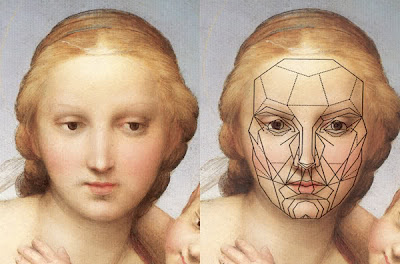But computers have major consequences for the "demand" side of the equation: what viewers want.
We have already witnessed the first primitive applications of computers to understanding what kind of art viewers like and why:
1. In 1994, artists Vitaly Komar and Alexander Melamid conducted a statistical analysis to calculate the ideal painting for U.S. audiences. They discovered that 60% of the population preferred paintings that are "realistic looking" while 88% preferred outdoor scenes featuring lakes or rivers. 53% preferred paintings to have visible brush strokes. Komar and Melamid "translated the numbers into paint on canvas." Their analysis produced the following picture:

2. Information technology is being used to rank the greatest artworks of the 20th century: Economist David Galenson has proposed quantitative methods to rank art, such as the number of times pictures appear in art history textbooks. Other economists, such as Michael Rushton and Charles Gray feel this approach shows great promise. Says Gray: "We all want to believe that there is something special about the arts but I don't buy that there is any difference between artistic and economic value."
3. Other computer scientists take a different approach, claiming that "with the use of mathematics, computers and massive data bases of attractive faces, we have been able to quantify facial attractiveness in a consistent mathematical computer model...."

Building on historical archetypes of beauty, companies now claim to have calculated the formula for beauty and attractiveness: "it is a mathematical ratio that seems to appear recurrently in nature as well as other things that are seen as Beautiful. The Golden ratio is a mathematical ratio of 1.6180339887:1, and the number 1.6180339887 is called phi." Using computer programs and a trademarked "golden grid," an artist might tailor an image to what viewers would find most attractive.
But these early, sometimes laughable efforts have given way to more sophisticated applications of information technology. Rather than gathering raw data through telephone surveys the way Komar and Melamid did in 1994, science has gained the ability to monitor brain, blood, skin and other biological reactions to art. Until now, these nascent technologies (especially electroencephalography and infrared optical tomography) have found uses in the gaming and neuromarketing industries:
[neuromarketing is] a new field of marketing which studies consumers' sensorimotor, cognitive, and affective response to marketing stimuli. Researchers use technologies such as functional magnetic resonance imaging (fMRI) to measure changes in activity in parts of the brain, electroencephalography (EEG) to measure activity in specific regional spectra of the brain response, and/or sensors to measure changes in one's physiological state (heart rate, respiratory rate, galvanic skin response) to learn why consumers make the decisions they do, and what part of the brain is telling them to do it.Would a CGI picture evoke a better reaction if the hero's shirt was blue rather than red, or the heroine had longer hair? Would a CGI animated kiss come across as more passionate if it were five seconds longer or shorter?
Computers can identify the electrical activity in the brain that accompanies the thrill of seeing a good work of art. They monitor localized changes of oxy- and deoxy-hemoglobin concentrations in the brain in response to various images. With increasing precision, computers are likely to explain the pharmacological activity that accompanies a diverse range of artistic thrills.
From there, it will become much easier (and more efficient) to stimulate those same reactions by skipping over that obsolete middle man between the work of art and the audience: the artist, who struggled for centuries relying on nothing but highly fallible intuition.